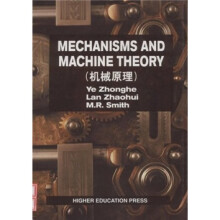Chapter1 Introduction
1.1 Study Object
1.2 Study Content
1.3 Purpose
Chapter2 Structural Analysis of Pianar Mechanims
2.1 Planar Kinematic Pairs and Planar Mechanisms
2.2 The Kinematic Diagram of a Mechanism
2.3 Degree of Freedom of a Mechanism
2.4 Points for Attention during the Calculation of DOF
2.5 The Composition Principle and Structural Analysis
Problems and Exercises
Chapter3 Kinematic Analysis of Mechanisms
3.1 Tasks and Methods of Kinematic Analysis
3.2 Velocity Analysis by the Method of Instant Centres
3.3 Kinematic Analysis by Analytical Methods
Problems and Exercises
Chapter4 Planar Linkage Mechanisms
4.1 Characteristics of Planar Linkage Mechanisms
4.2 The Types of Four-bar Linkages
4.3 Characteristics Analysis of Fou-bar Linkages
4.4 Dimensional Synthesis of Four-bar Linkages
Problems and Exercises
Chapter5 Cam Mechanisms
5.1 Characteristics and Classification of Cam Mechanisms
5.2 Follower Motion Curves
5.3 Plate Cam with Translating Roller(or Knife-edge)Follower
5.4 Plate Cam with Oscilating Roller Follower
5.5 Plate Cam with Translating Flat-faced Follower
5.6 Plate Cam with Oscillating Flat-faced Follower
Problems and Exercises
Chapter6 Gear Mechanisms
6.1 Types of Gear Mechanisms
6.2 Fundamentals of Engangement of Tooth Profiles
6.3 The Involute and Its Properties
6.4 Standard Involute Spur Gears
6.5 Gearing of Involute Spur Gears
6.6 Contact Ratio of an Involute Spur Gears Set
6.7 Manufacturing Methsds of Involute Profiles
6.8 Addendum Modification on Involute Spur Gears
6.9 Helical Gears for Parallel Shafts
6.10 Worm Gearing
6.11 Bevel Gears
Problems and Exercises
Chapter7 Gear Trains
Chapter8 Other Mechanisms in Common Use
Chapter9 Combined Mechanisms
Chapter10 Balancing of Machinery
Chapter11 Motion of Mechanical Systems and its Regulation
Chapter12 Creative Design of Mechanism Systems
Vocabulary
References
前言

 缺书网
缺书网 扫码进群
扫码进群





